Steven Pifer testifies before the U.S. Commission on Security and Cooperation in Europe on the growing Russian military threat in Europe, assessing and addressing the challenges by looking at Ukraine as a case study. Watch the hearing live »
Introduction
Mr. Chairman, Co-Chairman Smith, members of the Commission, thank you for the opportunity to appear today to testify on the growing Russian military threat to Europe and how that threat has manifested itself in Ukraine.
From the perspective of the 1975 Helsinki Final Act, Russia’s military aggression against Ukraine has been the most shocking development in Europe since the end of the Cold War and collapse of the Soviet Union. The Russian seizure of Crimea in March 2014, followed by its illegal annexation, violated fundamental principles of the Final Act. Those principles include the commitment of participating states to respect each other’s sovereignty, territorial integrity and independence, and to refrain from the threat or use of force against the territorial integrity or independence of any state. The principles also include the principle that borders can be changed only by peaceful means and agreement. Russia’s actions in Crimea have violated all of those commitments.
The Kremlin did not stop with Crimea. Russia military and security service personnel have been deeply engaged in the Donbas region of eastern Ukraine since April 2014, where fighting has claimed some 10,000 lives. Russian involvement in the Donbas has included the provision of leadership, financing, ammunition, heavy weapons, supplies and, in some cases, regular units of the Russian army to support armed separatism against the Ukrainian government, also in violation of Russia’s Final Act commitments.
Unfortunately, and despite the efforts of the leaders of Germany and France, the conflict in Donbas shows no sign of settlement. There is little evidence to suggest that Russia and the separatist forces under its control want to end the conflict. The Kremlin appears to see value in maintaining a simmering conflict as a means to put pressure on and destabilize the government in Kyiv, in order to make it harder for Ukraine to get on with needed domestic reforms and implement its association agreement with the European Union.
It is important for European security that the United States and the West support Ukraine and stand up to Russia. It would be a mistake to let the Kremlin conclude that the kind of tactics it has employed against Ukraine could be applied elsewhere against another member of the Organization for Security and Cooperation in Europe (OSCE).
Russia’s Goals in Europe and Ukraine
In the 1990s and early 2000s, many analysts assumed that Russia wanted to work in a cooperative manner with the United States and Europe and, if not integrate into, develop cooperative relationships with key European and trans-Atlantic institutions such as the European Union and NATO. In recent years, however, it has become clear that Russian President Vladimir Putin and the Kremlin leadership have chosen a different course. They appear to have concluded that the European security order that developed in the aftermath of the Cold War disadvantages Russian interests. They have sought to undermine that order and define Russia in opposition to the United States and the West.
Russia is pursuing several goals in Europe. First, the Kremlin seeks a Russian sphere of influence—or a “sphere of privileged interests,” as then-President Dmitry Medvedev called it in 2008—in the post-Soviet space, with the possible exception of the Baltic States. Mr. Putin does not seek to recreate the Soviet Union, as the Russian economy is not prepared to subsidize the economies of the other former Soviet states. What the Russian leadership wants from its neighbors is that they defer to Moscow on issues that the Kremlin defines as key to Russian interests. This includes relationships between those states and institutions such as the European Union and NATO, despite Russia’s commitment under the Final Act to respect the right of other states to choose to belong to international organizations and to be party to treaties of alliance.
Second, Moscow seeks to weaken the European Union and NATO, which it believes act as checks on Russian power. Russian security doctrine openly regards NATO as a threat. Mr. Putin appears to hold a particular grievance against NATO. He asserts that the Alliance began enlarging in the early 1990s in order to take advantage of Russian weakness and bring military force to Russia’s borders. His narrative ignores NATO’s efforts to engage Russia in a cooperative manner as well as the commitments undertaken by the Alliance with regard to the non-stationing of nuclear and conventional forces on the territory of new member states, commitments made to ease Russian concern about NATO enlargement.
The Kremlin also regards the European Union and its enlargement as a threat. Indeed, the Russian pressure that began on Ukraine in 2013 was not due to that country’s relationship with NATO. Then-President Victor Yanukovych had renounced the goal of securing a NATO membership action plan, and key Alliance members such as Germany and France had made clear that they did not support putting Ukraine on a membership track. What spurred Russia to increase its pressure was the prospect that Ukraine—even under Mr. Yanukovych—might conclude an association agreement with the European Union.
Third, the Kremlin seeks a seat at the table when major questions regarding Europe are decided. This explains in part Russia’s opposition to the European Union and NATO; Russia does not belong to those institutions. While Russia is a member of OSCE, it has devalued the status of the organization over the past two decades, regularly calling into question its mission and, at times, even its legitimacy.
Russia’s more assertive and belligerent stance in Europe over the past five years has been abetted by the modernization of Russian military forces, both nuclear and conventional. Much of the modernization of Russian strategic nuclear forces appears to be replacing old weapons systems with new versions—in some cases, systems Moscow might have replaced years ago had it then had the finances. The overall strategic modernization program appears sized to fit within the limits of the 2010 New Strategic Arms Reduction Treaty.
More worrisome, particularly for European security, are Russia’s deployment of a new ground-launched intermediate-range cruise missile in violation of the 1987 Intermediate-range Nuclear Forces Treaty, its modernization of an array of other non-strategic nuclear weapons, and its apparent “escalate to de-escalate” doctrine. Formal Russian doctrine suggests that Russia would resort to use of nuclear weapons in the event that nuclear or other weapons of mass destruction were used against Russia or an ally, or in the event of a conventional attack on Russia in which the existence of the Russian state is at stake. There have, however, been suggestions that Moscow might entertain the notion that it could use nuclear weapons to “de-escalate” a conventional conflict that did not involve an attack on Russian territory, for example, after a Russian conventional attack on another country.
Russia is also modernizing its conventional military forces. While much of this appears to be replacing old with new, the Russian military clearly aims to enhance its ability to conduct offensive operations outside of Russian territory, spurred in part by a desire to improve on the mediocre performance of Russian forces in the 2008 Georgia-Russia conflict. Over the past three years, it appears that Russia has deployed and operated a number of its new conventional weapons systems in Ukraine.
Domestic Drivers of Russian Policy toward Ukraine
Domestic political factors constitute major drivers of Russian policy toward Ukraine. For the Kremlin, regime preservation is job number one. During his first two terms as president in 2000-2008, Mr. Putin based regime legitimacy on economics—at a time when the Russian economy was growing at a rate of about seven percent per year. However, when he prepared to return to the presidency in 2011, Russia faced a grim economic situation. Accordingly, Mr. Putin included heavy elements of nationalism, Russia’s return as a great power, and anti-Americanism in his campaign. Those themes now appear the basis for regime legitimacy, and it is likely that they will feature in Mr. Putin’s campaign for reelection in March 2018.
Those themes in turn drive aspects of Moscow’s foreign policy, and they play in particular with regard to Ukraine. From 1654 until 1991, Ukraine was a part of the Russian Empire and then the Soviet Union, with the exception of a few years after World War I. Of all the republics that Moscow lost when the Soviet Union collapsed, Ukraine’s loss pains Russians the most. Many Russians consider Ukraine “little Russia.” Indeed, when he made his last visit to Kyiv in summer 2013, Mr. Putin referred to Russians and Ukrainians as one people—to the unhappiness of many Ukrainians, who felt that he thereby denied their history, language and culture.
Mr. Putin, moreover, appears to fear that a successful Ukraine could affect the attitudes of the Russian people. If Ukraine succeeds in building a stable, modern, democratic state with a robust market economy, Russians may begin to wonder why they cannot have a more democratic form of governance in place of the increasingly authoritarian power structure that has developed in Russia over the past seventeen years. While Mr. Putin enjoys high approval ratings—typically in the 70-80 percent range—the Kremlin seems constantly nervous about its hold on the Russian public. The Kremlin thus does not want a successful Ukrainian neighbor and is prepared to go to great lengths to hinder that success, including the use of military force.
The Maydan and Russia’s Illegal Seizure of Crimea
In February 2014, the violent end of the Maydan Revolution, Mr. Yanukovych’s decision to flee Kyiv, and the Rada (Ukraine’s parliament) vote to appoint an acting president and acting prime minister who made drawing closer to the European Union Ukraine’s top foreign policy priority caught Moscow by surprise. The Kremlin reacted quickly.
Mr. Putin told a Russian documentary a year later that he decided early on the morning of February 23 to activate a plan to seize the Crimean peninsula. Shortly thereafter, soldiers in Russian-style combat fatigues—but lacking identifying insignia—began to occupy key installations and crossroads on the peninsula.The soldiers were clearly professional military, as evidenced by how they handled their weapons and themselves.
Ukrainians dubbed these soldiers “little green men.” Asked on March 4 whether the soldiers were Russian, Mr. Putin denied they were, describing them as “local self-defense forces.” Asked about their Russian combat fatigues, he replied that one could find those in military surplus stores across the former Soviet Union. On March 28, however, Mr. Putin congratulated Russian military officers on their conduct of the Crimean operation. In a May 18 telethon, he admitted that the “little green men” had been Russian soldiers. The Ministry of Defense issued a medallion commemorating the Russian military’s role in the “return of Crimea,” an operation which the medallion dated as running from February 20 (three days before Mr. Putin said he ordered Crimea’s seizure) through March 18.
Russia’s swift seizure of Crimea was aided particularly by two factors. First, there were already substantial Russian military forces and infrastructure on the peninsula, deployed there per agreement with Ukraine at bases and facilities for the Russian Black Sea Fleet and supporting units. Second, Ukrainian military forces stayed in garrison and did not challenge the Russians, reportedly in part due to urgings from Washington that Ukraine do nothing to provoke Russian escalation. As many soldiers in the Ukrainian units were from Crimea, commanders likely had questions about their unit’s reliability.
By March 6, Russian forces had control of all major locations in Crimea, had blocked Ukrainian forces in their bases, and had laid a minefield to cordon off the peninsula from the Ukrainian mainland. Under the leadership of a newly appointed prime minister who reportedly was once known as the “Goblin” in local organized crime circles, the Crimean parliament voted to join Russia and to schedule a referendum. That referendum, conducted on March 16, offered two choices: to join Russia, or to reinstate Crimea’s 1992 constitution, which would have granted the peninsula substantially greater autonomy from Kyiv. Those who wanted Crimea to remain a part of Ukraine under the existing constitutional arrangement found no box to check.
Crimean authorities reported that 83 percent of eligible voters took part in the referendum, with nearly 97 percent voting to join Russia. Few found the result credible. There were numerous reports of irregularities, armed personnel near voting stations, and journalists with Russian passports allowed to vote. Other estimates indicated a much smaller voter turnout than that reported by Crimean and Russian officials. According to a report that appeared later on the website of the Russian president’s human rights ombudsman, only 30-50 percent of the Crimean electorate actually took part in the referendum, with only 50-60 percent of those choosing to join Russia.
In any event, Crimean representatives and Russian officials two days later concluded a treaty on Crimea joining Russia. The Russian Federal Assembly ratified the treaty on March 21. The annexation of Crimea proved very popular with the Russian public, and it gave a boost to Mr. Putin’s approval rating. He apparently remembers that; the 2018 presidential election in Russia has been scheduled for March 18, the fourth anniversary of the treaty on Crimea joining Russia.
The United States and European Union responded to Crimea’s illegal annexation by applying visa and financial sanctions on individuals connected to the seizure. The leaders of the United States, Canada, France, Germany, Italy, Japan and United Kingdom agreed to exclude Russia from the G8 and revert to the G7. President Barack Obama signed an executive order to enable broader sanctions against the energy, financial and defense sectors of the Russian economy.
Russia’s Involvement in the Donbas
Russia did not stop with Crimea. In early April 2014, “little green men” appeared along with armed local separatists in several major cities in eastern Ukraine, particularly in the Donbas region of Donetsk and Luhansk. In contrast to Crimea, this time Ukrainian security forces resisted, and fighting broke out in several locations.
The U.S., Russian and Ukrainian foreign ministers, joined by the European Union’s high representative for common foreign and security policy, met in Geneva on April 17 and agreed on a settlement that called for an end to the violence, the disarming of illegal armed groups, and the evacuation of occupied public buildings. The settlement also called on OSCE to monitor the agreed measures. Separatist leaders in Donbas, however, immediately indicated that they would not observe the Geneva terms.
The fighting continued and spread, with the separatist forces gaining control of more of the Donbas. Russia provided leadership, financing, ammunition, heavy weapons and other supplies. In addition, “political tourists” began arriving from Russia to swell the ranks of the separatist fighters. While the separatists at first claimed they got their heavy weapons by seizing them from Ukrainian forces, equipment showed up in their ranks that had never been in the Ukrainian military’s inventory but was in the Russian military’s inventory.
The United States began to impose additional sanctions on Russia, as fighting in the Donbas continued and spread further. On the battlefield, however, Ukrainian forces began to gain the upper hand during the early summer. Russia responded by accelerating the flow of tanks, armored personnel carriers, artillery, advanced anti-aircraft systems and “volunteers” to assist the separatists.
The anti-aircraft systems provided by Russia included the Buk (SA-11) surface-to-air missile that shot down a Malaysia Airlines Boeing 777 on July 17 over the occupied part of the Donbas. All of the nearly 300 passengers and crew perished. A separatist leader almost immediately claimed credit for downing a Ukrainian military transport plane at the same time and location of the Malaysia Airlines shootdown. It appears that the separatist forces fired on the civilian airliner by mistake. Reports and photos that were issued later tracked the Buk missile launcher through territory occupied by the separatists, including the transport of the launcher—minus one missile—back in the direction of Russia.
In the aftermath of the shootdown, the United States and European Union adopted substantial new sanctions against Russia. These included sanctions aimed at the financial, energy, high tech and defense sectors.
Ukrainians forces continued to make progress. By mid-August, they had greatly reduced the amount of territory under Russian/separatist control, had split that territory into two pockets, and appeared on the verge of regaining control of all of the Donbas. On or about August 23, however, regular units of the Russian army, supported by heavy artillery and rocket strikes, entered Ukrainian territory and dealt a severe blow to Ukrainian forces. They inflicted heavy casualties on the Ukrainians and, by some estimates, destroyed 50-70 percent of the armor deployed in the area by the Ukrainian army. The Russian/separatist attack recovered much of the territory that had been lost in the two previous months.
Ukrainian representatives met with officials of the so-called Donetsk and Luhansk “people’s republics” in Minsk on September 5 and worked out a ceasefire in the presence of Russian and OSCE officials. However, the ceasefire never took full hold, with particularly sharp fighting continuing around the Donetsk airport and in areas east of Mariupol, on the Sea of Azov. By the beginning of 2015, Russian/separatist forces had seized roughly 500 square kilometers of territory beyond the September 5 ceasefire line.
After a December lull, fighting accelerated again in January and early February 2015. At that time, NATO military officials estimated that 250-1,000 Russian military and military intelligence officers were in the occupied part of the Donbas, providing command and control and serving as advisors and trainers to the separatists as well as to “volunteers” from Russia. NATO officials believed that Russian personnel also operated the more sophisticated Russian military equipment. At that point, NATO did not believe that Russia had regular military units in Ukraine but noted that some 50,000 Russian troops had been deployed on the Russian side of the Ukraine-Russia border.
Ukrainian sources had a different estimate. They believed that Ukrainian forces faced a total of 36,000 Russian troops and separatist fighters in the Donbas. Of that total, the Ukrainians believed that 5,000-10,000 were Russian soldiers, though the bulk of the separatist fighters were Ukrainian citizens.
In February 2015, German Chancellor Angela Merkel and French President Francois Hollande brokered a settlement agreement between Ukrainian President Petro Poroshenko and Mr. Putin. That agreement—often referred to as the Minsk II accord—provided for a ceasefire, withdrawal of heavy weapons from the line of contact, and access for OSCE monitors to confirm the ceasefire and withdrawal. Minsk II also contained a number of additional measures designed to resolve the conflict and restore Ukrainian sovereignty over the Donbas, including withdrawal of all foreign forces, passage of a constitutional amendment on decentralization of political authority, an election law for the occupied region, a status law for the Donbas, and restoration of Ukrainian control of the full Ukraine-Russia border. The terms of Minsk II are clearly less favorable to Ukraine than the terms worked out in Minsk I in September 2014—in effect, a reward to the Kremlin for not observing the Minsk I agreement.
Minsk II got off to an inauspicious start. Russian and separatist forces launched a major assault on Ukrainian units in the Debaltsevo salient between the cities of Donetsk and Luhansk. They ratcheted down the fighting after capturing the territory but, as with the September 2014 ceasefire, the Minsk II ceasefire never really took hold—despite numerous subsequent attempts to negotiate a sustainable ceasefire.
A familiar pattern emerged over the next two years: shelling and fighting along the line of contact would flare up, followed by lulls and newly negotiated ceasefires, which never held and sometimes never even took effect. While both sides committed ceasefire violations, observers have attributed primary responsibility for violations to Russian/separatist forces.
As in the early days after the Crimean operation, Mr. Putin and the Kremlin deny there are any Russian military personnel in the Donbas—despite pictures of heavy weapons known only to be in the Russian inventory, the capture of Russian military personnel by Ukrainian forces, and the spotting by OSCE observers and Russian television of soldiers in Russian uniforms with Russian insignia. The Kremlin instead implausibly claims that all the separatist fighters are locals or “volunteers” from Russia.
NATO believes that the command structure for Russian/separatist forces in the occupied Donbas continues to consist of Russian military officers, while irregulars form the bulk of the armed personnel, though they have been and can be augmented by regular Russian army units if needed. The Ukrainian security service says that it has identified specific Russian military officers who occupy command positions in the forces of the so-called Donetsk and Luhansk “people’s republics.” The Ukrainian military and security service continue to believe that a larger portion of the fighters in the Donbas are active-duty Russian military personnel and that some are in organized Russia units.
Shelling and fighting continue along the line of contact in the Donbas. On most days, the Ukrainian military reports suffering killed and/or wounded in action.
The line of contact between Ukraine and the occupied part of the Donbas appears to be hardening. Leaders of the Donetsk and Luhansk “people’s republics” have said that they will not permit a restoration of Ukrainian sovereignty—even though that is a central objective of Minsk II. The two statelets use the Russian ruble as their currency and have begun issuing passports, which the Russian government recognizes. On the other side, Ukraine has imposed a trade embargo on occupied Donbas and cut off the supply of electricity to the occupied part of Luhansk. This hardening of the line of contact will make it more difficult to achieve an eventual settlement.
The United States and European Union have regularly renewed sanctions on Russia and maintained a common line. Chancellor Merkel has repeatedly stated that full implementation of Minsk II is the prerequisite for easing sanctions, a position echoed by the Obama administration and, in its first months, by Trump administration officials.
What is Russia Seeking in Ukraine
By all appearances, the Kremlin is not implementing the Minsk II agreement and, at this point in time, apparently calculates that a simmering conflict in the Donbas better serves its interests. Such a conflict makes it more difficult for the government in Kyiv to pursue needed political and economic reforms or to implement the association agreement with the European Union. That is, it makes it harder for Ukraine to become a successful state and deepen links that will keep it out of a Russian sphere of influence.
Moscow is clearly unhappy about Western economic sanctions, yet it has eschewed steps that would lead to their easing. For example, it would not be difficult for the Kremlin to enforce a real ceasefire, given its control over Russian/separatist forces in the Donbas. It could also implement a withdrawal of heavy weapons away from the line of contact. If the Russians feared that the Ukrainian military might try to take advantage of the situation, they could visibly position additional Russian military units along the Russia-Ukraine border as a deterrent. Having implemented the ceasefire and withdrawal steps, OSCE monitors could then be invited to travel freely around the occupied part of the Donbas to confirm that the measures had been implemented.
Were the Kremlin to take these steps, the focus for implementation of Minsk II would shift to Kyiv. Political and public attitudes have understandably hardened over the past two years due to the continued fighting and casualties. The Ukrainian government could well find that it would have a difficult time implementing certain Minsk II provisions, such as the passage of a constitutional amendment on decentralization or an election law for the Donbas. If Ukraine could not deliver on those provisions, the stage would be set for Moscow to make a bid for the easing of sanctions on Russia.
Why has the Kremlin not taken such a step? The most plausible reason would appear to be that the Russians fear that Ukraine might be able to do its part to implement Minsk II. A settlement of the Donbas conflict at this point, however, does not appear to be a Kremlin objective. The Russian leadership instead sees advantages to maintaining a simmering conflict that it can use to put pressure on and destabilize the government in Kyiv.
The Russian leadership may have other reasons for holding to its present course. While Moscow was disappointed by election outcomes earlier this year in the Netherlands and France, Germany holds its elections in September. Polls indicate that Ms. Merkel remains the most popular politician, and her victory appears increasingly likely, but she is running for reelection for a fourth term at a time when many Western voters seek change. Ms. Merkel has provided the linchpin for European Union policy toward Russia and Ukraine, and the Russians no doubt would welcome her departure from office. That election gives Moscow an incentive to wait, in hopes that a change in Berlin might lead to a different German and European Union policy toward Russia—without Moscow doing anything to implement Minsk II.
The Role of OSCE
OSCE has played an important role in trying to resolve the conflict in the Donbas. The Trilateral Contact Group is headed by a special representative of the OSCE Chairperson-in-Office. In addition to OSCE, representatives of Ukraine and Russia are the other formal participants, and representatives of the Russian/separatist-occupied parts of Donetsk and Luhansk often take part. The Trilateral Contact Group has four working groups, which address political, security, humanitarian and economic questions. It has several times attempted to work out a true ceasefire, but with little success.
OSCE also provides a special monitoring mission, which is a civilian, unarmed mission that operates throughout Ukraine. The special monitoring mission currently has about 700 monitors. Many of them are deployed in eastern Ukraine, where the mission has been tasked with observing and reporting on the implementation of the Minsk II provisions on a ceasefire and withdrawal of heavy weapons from the line of contact. Unfortunately, the reports all too often document where Minsk II provisions are not observed. Still, the OSCE mission is important for the credibility of its observations, when there are often conflicting reports as to developments on the ground.
OSCE also maintains an observer mission at two checkpoints on the Russian border with occupied parts of the Donbas: Gukovo and Donetsk. While that presence allows reporting of what crosses from Russia into Ukraine (and vice-versa) at those two locations, there are many other border crossing points where Russian and separatist forces can cross freely without being observed by OSCE or other monitors on the ground.
Were Minsk II to be implemented, the special monitoring mission could expand its work and observe how additional Minsk II provisions were being implemented. OSCE also maintains a project coordinator in Kyiv to synchronize various OSCE activities aimed at promoting a variety of programs, including in the areas of constitutional, legal, human rights, media freedom, election and governance reforms.
The OSCE Permanent Council in Vienna provides a venue for the member states to exchange views on the Ukraine-Russia conflict and the situations in the Donbas and Crimea. Western delegations frequently use that forum to highlight where Russia or the separatists have violated Minsk II or OSCE commitments, such as to respect human rights. Such naming and shaming may not suffice to overcome Moscow’s reluctance to implement Minsk II, but it serves to spotlight where the problem lies.
OSCE has not, however, been able to play a larger role in forcing a settlement to the ongoing conflict in the Donbas or the unsettled status of Crimea. That reflects the limitations of an organization that operates by consensus, in which Russia can block any OSCE effort with which it disagrees. For example, the Ukrainian government has in the past suggested that an armed OSCE police force might help to stabilize the situation in the Donbas, a proposal that has little chance of being developed given Russian opposition.
More broadly, Russia’s aggression against Ukraine has weakened OSCE. One of the fundamental purposes of the organization is to promote a more peaceful, stable and secure Europe. Moscow’s seizure of Crimea and actions in the Donbas undercut that goal and, unfortunately, make OSCE appear less effective as an organization.
U.S. and Western Policy
The United States and the West should continue to provide political support to Kyiv and, provided the Ukrainian government more effectively implements economic reforms and anti-corruption measures, additional economic assistance. It is also important that the United States continue to provide military assistance. This should include certain types of lethal assistance for the Ukrainian military, in particular man-portable anti-armor weapons, to increase the Ukrainians’ capability to deal with the influx of Russian armor into the Donbas. The purpose of such assistance is not to give the Ukrainian military the ability to retake the Donbas. The military leadership in Kyiv understands that they cannot defeat the Russian army. The purpose of such assistance is to give the Ukrainians the ability to deny the Russian/separatist forces the ability to make easy gains, to deter further offensive actions, and to encourage the Kremlin to pursue a political settlement.
In parallel, U.S. and Western policy should aim to press Moscow to change its course in Ukraine and, as a matter of priority, work for a reasonable settlement in the Donbas. That is necessary to stop the fighting that has claimed some 10,000 lives.
The United States, European Union and other Western countries should continue to put political and economic pressure on the Kremlin. That means avoiding business as usual. When Mr. Putin observed the military parade in Red Square at Russia’s VE Day commemoration on May 9, the only foreign leader to join him was the president of Moldova. That conveys to the Russian people a sense of the political isolation brought about by the Kremlin’s policies. Mr. Putin clearly would like some normalization of the relationship with Washington. The Trump administration should make clear that Russia’s aggression against Ukraine poses a major obstacle to such normalization.
Continuing to put pressure on the Kremlin also means maintaining the current economic and other sanctions that have been applied against Russia. To encourage Moscow to alter its course of maintaining a simmering conflict in the Donbas, the West should consider increased economic sanctions as well as an expansion of the number of Russian individuals targeted for visa bans and asset freezes; broadening visa bans to apply to family members could dramatically increase their impact. However, finding agreement on such steps could be difficult with the European Union, when some member states wish to return to business as usual with Moscow. It is also unclear if the Trump administration would favor additional sanctions. Congress should encourage the administration to do so.
In addition, it is important that the administration and NATO continue the steps agreed at last year’s NATO summit in Warsaw to enhance the Alliance’s conventional deterrence and defense capabilities in the Baltic region and Central Europe. Such steps will lead to more secure European allies who will be more confident in supporting Ukraine.
The United States should also continue to support the German and French efforts to promote a solution to the Ukraine-Russia conflict. It is very difficult to see Minsk II being implemented, in large part due to Moscow’s demonstrated disinterest. But Minsk II remains the only settlement process on the table, and Washington should encourage Kyiv to continue to engage. If Minsk II collapses—some might say when it collapses—it should be clear that Russia and the separatists bear full responsibility.
It is important to continue to engage Moscow. At the end of the day, Ukraine needs a settlement that has Russian buy-in. Otherwise, Moscow has too many levers that it can use to make life difficult for Kyiv and deny Ukraine a return to normalcy.
Finally, on Crimea. While one might envisage a settlement regarding the Donbas at some future point, it is all but impossible to imagine Mr. Putin or any future Russian leader agreeing to Crimea’s return to Ukraine. At present, Kyiv lacks the political, economic and military leverage to change that. The Donbas fighting has been far more deadly, but the seizure of Crimea has been more destructive of the cardinal tenet of the Final Act: that states should not use military force to change borders or take territory from other countries. The United States and the West should not accept this. They should continue a policy of non-recognition of Crimea’s illegal annexation and continue sanctions related to the peninsula until such time as Ukrainian sovereignty is restored or the Ukrainian government reaches some other settlement with Russia.
Conclusion
Mr. Chairman, Co-Chairman Smith, members of the Commission,
Over the past three years, Russia has employed military force to seize Crimea, and instigate and sustain a bloody armed conflict in the Donbas in pursuit of the Kremlin’s goal of asserting a sphere of influence in the post-Soviet space and frustrating the ability of Ukrainians to realize their ambition of becoming a normal democratic European state.
These Russian actions are in stark violation of Russia’s commitments under the Helsinki Final Act and other agreements, including the 1994 Budapest Memorandum on Security Assurances to Ukraine. These actions endanger peace and stability in Europe. Moreover, they raise concern that the Kremlin might be tempted to use force elsewhere in Europe.
The United States should work with its European partners to respond in a serious way. They should continue to provide Ukraine with political, economic and military support; maintain and intensify economic and other sanctions on Russia to induce a change in Kremlin policy; and keep open channels of communication for a settlement if Moscow alters its policy. This will require a sustained, patient effort. That is essential if we wish to realize the kind of Europe that was envisaged when the Final Act was signed in 1975.
The Brookings Institution is committed to quality, independence, and impact.
We are supported by a diverse array of funders. In line with our values and policies, each Brookings publication represents the sole views of its author(s).
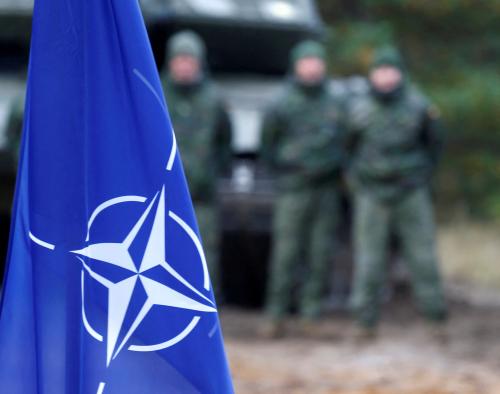
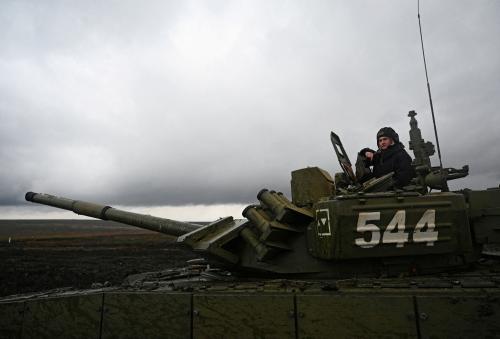
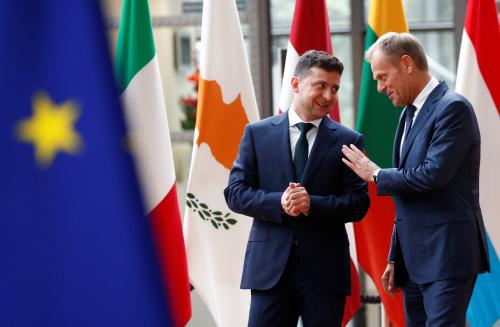
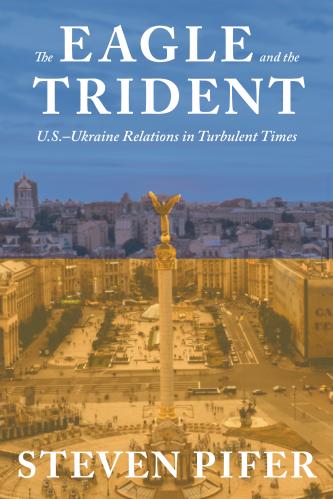


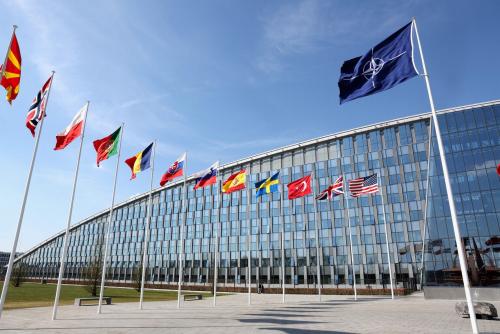
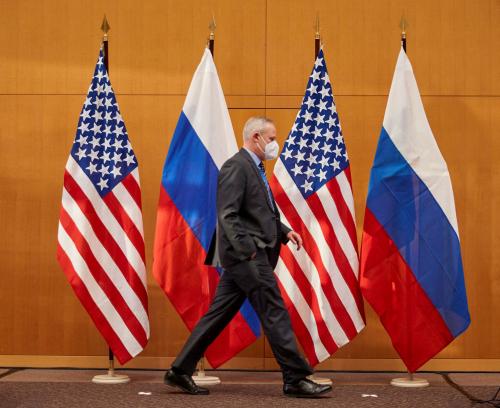
Commentary
TestimonyThe growing Russian military threat in Europe
Assessing and addressing the challenge: The case of Ukraine
May 17, 2017